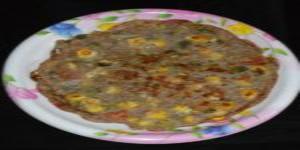
Fundamental Concepts and Principles
The primary ingredients in rotis/pancakes are stone ground flour, salt (optional), and water to form the dough. Rotis are made into savories with the use of jaggery, coconut, etc.
- ½ Padi Corn/Pearl Millet/Finger Millet Flour
- ? Palam Salt
- As per requirement Water
1. Take ½ padi of any one of the grains mentioned above, smash the grains and remove the skin. Grind the grains to make flour and keep aside.
2. Add salt to the flour.
3. Knead the flour with water and keep the dough aside for 1 hour.
4. Later knead it again and take a mango size dough and flatten it with your hand on a flat surface to make it into thin circles like a pancake.
5. Using a dosa pan cook the pancake evenly on both the sides.
6. Once it turns slightly red and cooked, turnover to cook the other side. When both sides are done, take it off the pan and place it aside.
7. Jaggery can also be added to it (optional). To add Jaggery to the dough before kneading it, dilute the Jaggery in boiled/warm water first.
8. This pancake can be eaten with kootu (a stew made of many vegetables, gravy, or curd.
Method
A roti dough is rolled out into flat round, square or triangular shapes, and cooked on a flat or slightly concave iron (or clay) griddle called a tawa. There are also a variety of rotis made using a traditional Indian oven called the tandoor, especially in the state of Punjab, where the flattened dough is stuck to the inside wall of the tandoor, where it bakes quickly at a high temperature. In everyday life and homes, the roti rolled out is called chapati and is made of whole wheat flour mixed into dough with water, edible oil or ghee and optional salt in a mixing utensil called a parat, and is cooked on the tava. Variations of the chapati include the phulka (in Punjab, Maharashtra, Gujarat) and maani in Sindhi.
Some roti recipes do use a home-made souring process called khameer, as also buttermilk, yoghurt, etc., for variety and healthier options.
Hindu Compliance Body
The Hindu compliance body was established under the executive order of The Supreme Pontiff of Hinduism, dated August 14, 2020, order number 10010, under the title Reviving the Hindu Compliance System and Body
to create, promote, spread and teach the standard procedures for all products and services that are in compliance Hindu Shastras.
Copyright
HCS has the copyright of all its publications. No part of these publications may be reproduced in any form without the prior permission in writing to HCS. This does not preclude the free use, in the course of implementing standard, of necessary details mentioned above. Enquiries related to copyrights to be addressed to KAILASA.
